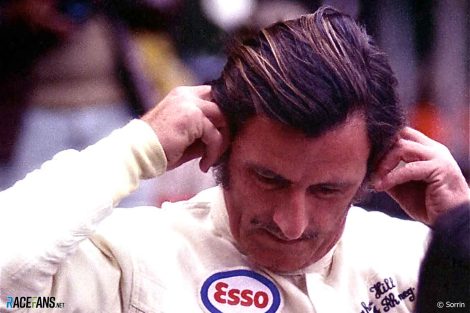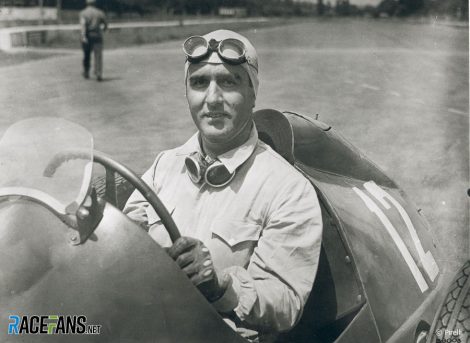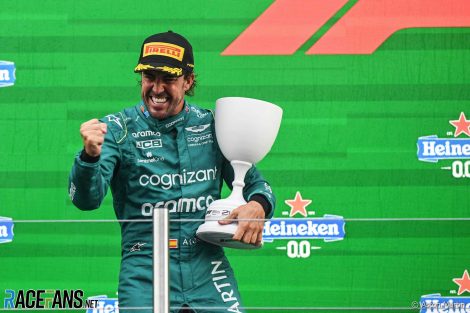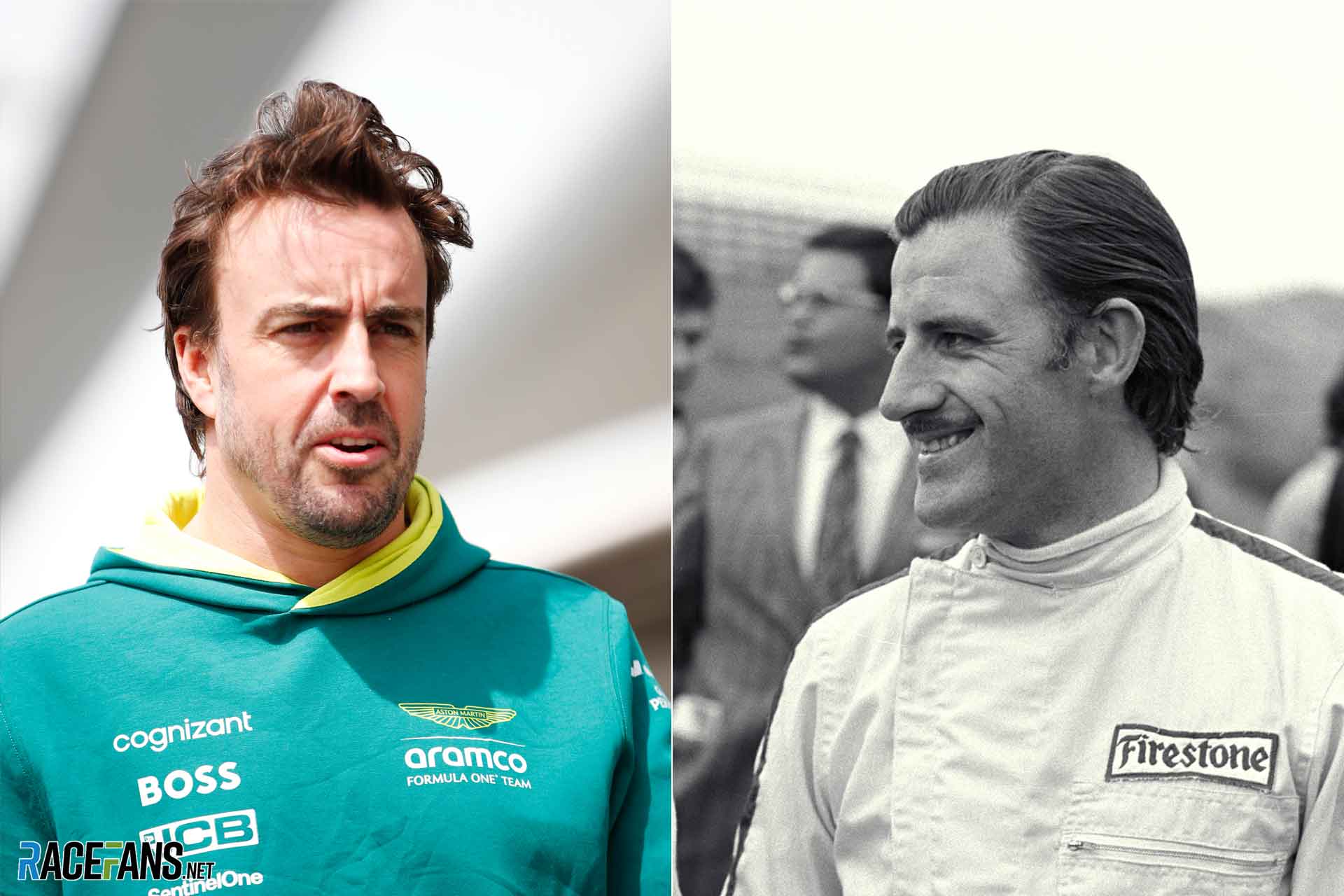Fernando Alonso’s new contract will see him become the oldest driver to take part in a Formula 1 race for more than five decades.
His new deal will keep him at Aston Martin at least until the end of the 2026 season. Assuming he sees out that deal and the season doesn’t end abnormally early, Alonso will be racing past his 45th birthday in July 2026.That will make him the oldest driver on the grid since another two-times world champion, Graham Hill, ended his career in 1975. Hill was 45 years and 345 days old when he started that year’s race at Interlagos.
He made two further attempts to qualify that year but didn’t make it onto the grid on either occasion. By the last race which Hill failed to qualify for, the Monaco Grand Prix, he had celebrated another birthday and was now 46 years and 85 days old. Since then, few drivers have raced on into their fifth decade.
Hill is an appropriate driver for Alonso to find symmetry with. Both are two-times world champions and both tackled the ‘triple crown’ of races with great success. Hill is the only driver to win the Monaco Grand Prix, Le Mans 24 Hours and Indianapolis 500, while Alonso has triumphed in the first two and tackled the latter three times.
*Verstappen, Hamilton and Alonso: Age at 2024 Japanese Grand Prix
Advert | Become a RaceFans supporter and
It wasn’t unusual for drivers to race into their forties and even fifties during the first decade of the world championship. But the dangers of the time also took a toll.

The fates of Jim Clark and Jochen Rindt – the only driver to win the championship posthumously – made some question why multiple champions Jack Brabham and Graham Hill kept racing so late in their careers. The former enjoyed a long retirement while the latter died in a plane crash soon after retiring.
But as the physical demands of driving cars grew in the late seventies, and new drivers started their careers earlier, those with the luxury of choosing when to end their careers increasingly did so in their thirties. Since Hill’s retirement only 10 drivers started grands prix after their 40th birthday:
| Driver | Age at last start | Last race |
|---|---|---|
| Vittorio Brambilla | 42 years, 308 days | 1980 United States Grand Prix |
| Mario Andretti | 42 years, 209 days | 1982 Las Vegas Grand Prix |
| Jacques Laffite | 42 years, 234 days | 1986 British Grand Prix |
| Rene Arnoux | 41 years, 124 days | 1989 Australian Grand Prix |
| Philippe Alliot | 41 years, 32 days | 1994 Belgian Grand Prix |
| Nigel Mansell | 41 years, 279 days | 1995 Spanish Grand Prix |
| Pedro de la Rosa | 41 years, 275 days | 2012 Brazilian Grand Prix |
| Michael Schumacher | 43 years, 327 days | 2012 Brazilian Grand Prix |
| Kimi Raikkonen | 42 years, 56 days | 2021 Abu Dhabi Grand Prix |
| Fernando Alonso | 42 years, 253 days | 2024 Japanese Grand Prix |
Advert | Become a RaceFans supporter and
Are we about to see a reversal of that trend? Despite the unceasing demands of Formula 1’s longest-ever calendars – 24 rounds again next year – there are strong factors pushing drivers towards longer careers.

As F1 has become so specialised, and the cars raced in single-spec junior categories so far removed from it, teams are increasingly reluctant to take a chance on youth. For the first time ever, the field at the opening race of this season was unchanged from the one which contested the previous year’s concluding race.
The value of experience to teams has therefore risen in recent years as rookies have less time to find their feet. First F1 slashed testing to almost nothing, lately it has cut back Friday practice sessions from 90 minutes to 60 and introduced sprint events where only a single practice session takes place. Ironically, few drivers have complained about this as vociferously as Alonso.

But others press on. Kimi Raikkonen was content to spend his last seasons racing the midfield. Hamilton has surprised himself by committing to race into his forties, taking up a once-in-a-career chance to join Ferrari, hoping to regain his lost, record-breaking eighth title.
As for Alonso, he clearly still has the love for racing. But he is also driven by a desire to claim his long-sought third world title, even if it takes him two decades or more.
Advert | Become a RaceFans supporter and
Become a RaceFans Supporter
RaceFans is run thanks in part to the generous support of its readers. By contributing £1 per month or £12 per year (or the same in whichever currency you use) you can help cover the costs of creating, hosting and developing RaceFans today and in the future.
Become a RaceFans Supporter today and browse the site ad-free. Sign up or find out more via the links below:
Formula 1
- Red Bull’s rival make upgrade push: Five Miami Grand Prix talking points
- How to watch the 2024 Miami Grand Prix
- “You need to be more on it”: 12 unheard radio exchanges from the Chinese GP
- F1 CEO Domenicali wants more than six sprint races per year
- Hulkenberg named Audi’s first F1 driver for 2026





BasCB (@bascb)
15th April 2024, 15:54
It IS interesting to see that safer cars and possibly their complexity (as well as the culture of corporations going for “safe bets” instead of taking risks with new talents and innovations in general), improvements in knowledge about our health and how to keep fit for a long time might be bringing back an era of having drivers go until well in their 40s.
Nick T.
15th April 2024, 22:33
Only the best of the best can do it because speed degrade. For example, Vettel didn’t just “realize there was more to life,” he was just plain mediocre by the time he retired. He even made Stroll look pretty good. I assume Hamilton will be back on top of his game next season but if he isn’t, it’ll make what FA is doing that much more impressive.
Nick T.
15th April 2024, 22:47
degrades*
Esploratore (@esploratore1)
16th April 2024, 9:14
Agree about vettel and I’m hopeful hamilton gets back to performing well next year, but if he doesn’t and sainz doesn’t get the red bull seat, it’ll be as much an injustice that hamilton took his seat at ferrari as vettel taking perez’s seat at force india, at least in the previous case you can argue perez got promoted to the team he deserved for his 2020 performances, but this time there doesn’t seem to be a better place to go for sainz.
Nick T.
18th April 2024, 21:49
Yup. I think it’ll add an extra layer of pressure for Lewis. He’ll be hoping Sainz struggles near the end of the season. All they remember is your last race after all.
Fer no.65 (@fer-no65)
15th April 2024, 16:00
I know it’s realistically almost impossible but the guy is still after it, so there are still chances, even slim ones. Just imagine if he did win a 3rd championship… what a story that would be! probably unique in all sports, period
Retired (@jeff1s)
15th April 2024, 16:49
Try and watch IndyCar, there’s a guy named Scott Dixon that’s winning races for 19 years in a row
Asd
15th April 2024, 19:23
Exactly! I keep saying this – Scott Dixon has been as consistent as Alonso, with the expection that it’s been bringing race wins and championships for almost 2 decades.
Gerrit
16th April 2024, 4:48
For 18 of those years he has been with one team. Amazing resilience by both driver and team.
Esploratore (@esploratore1)
16th April 2024, 9:15
Wow, that’s impressive, and I believe scott dixon was one of the few indycar drivers that were considered good enough to do well in f1 if he had wanted to.
MichaelN
15th April 2024, 16:27
For all its issues, the race in Qatar was a nice reminder of that. So many drivers complained when the constraints of the one-off tyre directive meant they were no longer ‘pacing’ themselves throughout much of the race. For the first time in a decade, many race best laps were only a second or so slower than qualifying. Sure, the temperature also played a part in the severity of the event, but it really emphasized how different the modern high-fuel Pirelli-nursing exercise is from the start-to-finish racing of the 2000s.
Some of the recent 40+ drivers also have one thing in common: they’re former champions. They tend to have marketing value, even at the back of the grid. It’s also quite telling, if not entirely surprising, that the only said driver to be in a race winning team was Michael Schumacher in 2012. And unlike Hamilton’s move to Ferrari, the ‘career extenders’ for Räikkönen and Alonso were firmly in the midfield, or worse.
Bullfrog (@bullfrog)
15th April 2024, 21:39
Apart from the year Alonso won his first title – 2005 with the whole-race tyres, sustainable ahead of their time and definitely not a desperate rule-change to stop Ferrari. (To be fair, 2006 was back to flat-out and pretty close)
Yes, Mercedes built a winning car for Schumacher, and Rosberg won. He was over the hill (nothing to do with Graham) by then. It’ll be fascinating to compare Hamilton at Ferrari, which is why it’s so frustrating to have to wait until next year.
SjaakFoo (@sjaakfoo)
15th April 2024, 18:20
Given that Alonso is the last of the drivers to be older than me (though obviously not by much), I must insist he continue driving for a long time so as to not make me face my mortality.
José Lopes da Silva
15th April 2024, 22:37
I fully agree and undersign this
Nick T.
18th April 2024, 21:52
We’re almost identical in age. It’s one of the reasons I’ve become a fan of his later in my F1 fandom.
Jeffrey Powell
15th April 2024, 18:40
Great comparison my wife has made a final judgement based on the photos ‘who’s that scruff next to Graham’. We do have a personally signed photo of the man with the moustache ( obtained in 1968).
David BR (@david-br)
16th April 2024, 0:35
I finally watched Dune Two last night and couldn’t shake the idea that Stilgar was actually performed by Alonso…
Nick T.
16th April 2024, 4:54
haha
How was Dune 2? I loved part 1.
David BR (@david-br)
16th April 2024, 12:51
Even better than Part 1, I thought. As a fan of the books and the director, I was happy! (I also loved Blade Runner 2049 if that’s anything to go by).
Nick T.
18th April 2024, 21:50
Think I’ll go try to see it in theatres today.
earthling (@34rthl1ng)
16th April 2024, 12:43
Bad hair day for Nando, really
Bullfrog (@bullfrog)
16th April 2024, 21:15
Maybe it was a day when Graham failed to qualify.
Nulla Pax (@nullapax)
15th April 2024, 20:31
Interesting – but – that first graph is just gobbledegook to me.
What is it supposed to show?
It isn’t alphabetical.
It isn’t based on age (else why is Max in-between Vettel and Hamilton?)
And did G Hill drive in almost 17 Thousand F1 GP’s? ….. impressive if true.
Maybe it’s me … maybe it’s the vodka … but I don’t get it ….
earthling (@34rthl1ng)
15th April 2024, 22:39
Well of course the horizontal axis is “Age at last race in days” but the axis legend is misplaced in the vertical axis
The drivers are assorted somewhat in chronological order from top to bottom but very roughly,
Mark Thomson (@melthom)
15th April 2024, 20:58
The younger drivers can sit in his lap when he tells stories about the good old days.
RR
15th April 2024, 23:24
…and they can fetch him his slippers and a hot water bottle.
Mark Thomson (@melthom)
16th April 2024, 10:18
+1
José Lopes da Silva
15th April 2024, 22:40
Here’s a 1994 stat still standing: Nigel Mansell is still the last F1 driver over 40yo to win a Grand Prix, although he should thank for Michael Schumacher’s precious help.
Who is going to beat that?
Crawliin-from-the-wreckage (@davedai)
16th April 2024, 1:18
Well strictly speaking Jack Brabham already did in the Dutch GP 1966.
He lapped the entire field.
Second was Graham Hill.
Third was Jim Clark.
Others said he was too old, so he wore a fake beard and had a walking stick prior to the race (yes there are photos)
But if you mean a full year past 40 then no.
Born 2nd April 1926
Won 1966 Dutch GP 24th July 1966.
Doubtful if either Hill’s Monaco/le Man’s/ Indy 500 or Brabham’ winning WDC and WCC in the same year will be equalled.
Crawliin-from-the-wreckage (@davedai)
16th April 2024, 1:27
Sorry I missed the last.
Apologies
José Lopes da Silva
16th April 2024, 22:01
…well, Fangio won several world titles after being 40 years old. I was mentioning that Mansell was just the last of them, until today
Esploratore (@esploratore1)
16th April 2024, 9:44
Well, alonso and hamilton have decent chances to beat that, I suppose, probably hamilton has a better chance cause of the car.
earthling (@34rthl1ng)
16th April 2024, 11:44
Nando does not have it easy to win another WDC, presumably Aston Martin is not going to deliver a good enough machinery. But a fluke race win seems perfectly possible for a driver who is still getting podiums. In fact Monaco last year was close and could have been a win if they had decided for the wet tyres in the crucial pitstop while Max was losing 18 seconds in a single lap.
L.G.
16th April 2024, 6:23
Personally I feel this dramatically undersells the effect of the monopolisation of the feeder series. The blunt truth of the matter is youth has less of a chance to get into F1 for a key reason: unless you can afford F2 and can beat the no-hopers that occupy too many seats in that overly expensive scam of a series, you don’t get a superlicense. This in turn creates a hard filter that only leaves teams with the choice of the middling, but proven hands and youngsters of which the majority will be mediocre at best. While thankfully the system has been flushed for this season a bit, before that for every Oscar Piastri, there were ten no-hopers like Richard Verschoor in F2, who only ever got results because they were stuck in F2 for so long they got to learn the ins and outs of the car – and F2 only recruits from European series to begin with, so only drivers who in the lower level can afford to leave their home continent early in their career even have a shot to even attempt that climb. All this has led to massively clogged pipeline that just about enough talent can go through for people to not notice there is a problem to begin with.
There are other reasons (only 20 cars, the peculiarities of F1 cars) for sure, but anyone who wants the answer why teams would rather bet on 40+-year old drivers than younger ones need mainly look at the superlicense points system.
Mayrton
16th April 2024, 7:10
Let’s hope Max won’t stay in F1 this long. The few spectators left could be looking at a 18 times WDC by then.
MacLeod (@macleod)
16th April 2024, 7:55
A bit too harsh but he will move on to other racing series after 2028,
MacLeod (@macleod)
16th April 2024, 7:58
I found the stats very interesting but i wonder if the amount of days they raced in F1 could be added for compairing. ( I think Alonso, Lewis and Kimi would be the ones with the longest careers)
earthling (@34rthl1ng)
16th April 2024, 12:35
But wait till Max retires!!
earthling (@34rthl1ng)
16th April 2024, 13:00
You mean the number of races (which is easy) or days since first to last race (which is slightly harder)
For the first one (from statsF1), the top 10 drivers are Fernando (382 GPs), Kimi (350), Carl Davidson (336) Rubens (323) Schuey (307) Jenson (306) Seb (299) Felipe (269) Checo (261), and Riccardo Patrese (256, did not expect that one, most are pretty recent obviously because there used to be a lot less races per season before the times of Schuey and Rubens.
For the longest F1 careers chronologically I found info here (right after Abu Dhabi 2023) and they are Nando again, Schuey, Kimi, Rubens, Carl Davidson, Jenson, Graham Hill, Patrese again, Luca Badoer and Felipe
Bullfrog (@bullfrog)
16th April 2024, 21:29
Luca Badoer, heh.
Jacques Laffite was interesting, raced competitively well into his 40s (in those mid-80s turbos which must have been a handful), rudely interrupted by a leg-breaking shunt, and Ligier were never the same without him.
MacLeod (@macleod)
17th April 2024, 8:12
Thanks that gives a idea how long they raced in the sport too! :)
Thank you for your effort!
Christopher
16th April 2024, 10:57
If Alonso were to win the title in a 2026 Honda Aston Martin, which is possible because who knows which team will get it right with new regulations, he’d go 21 years between titles. That would be like Verstappen winning this season, but then not winning again until 2045. That is an insane number, an insane stat. The longest gap between two consecutive titles is 6 seasons (Lauda’s 1977 to 1984).
manuel j martinez (@mr-moto)
16th April 2024, 21:23
The F1 record that will never be broken:
Fangio, 5 titles won after his 40th birthday.
José Lopes da Silva
16th April 2024, 22:07
The amount of records held by Fangio that will never be broken is astounding, especially if you add record by percentage